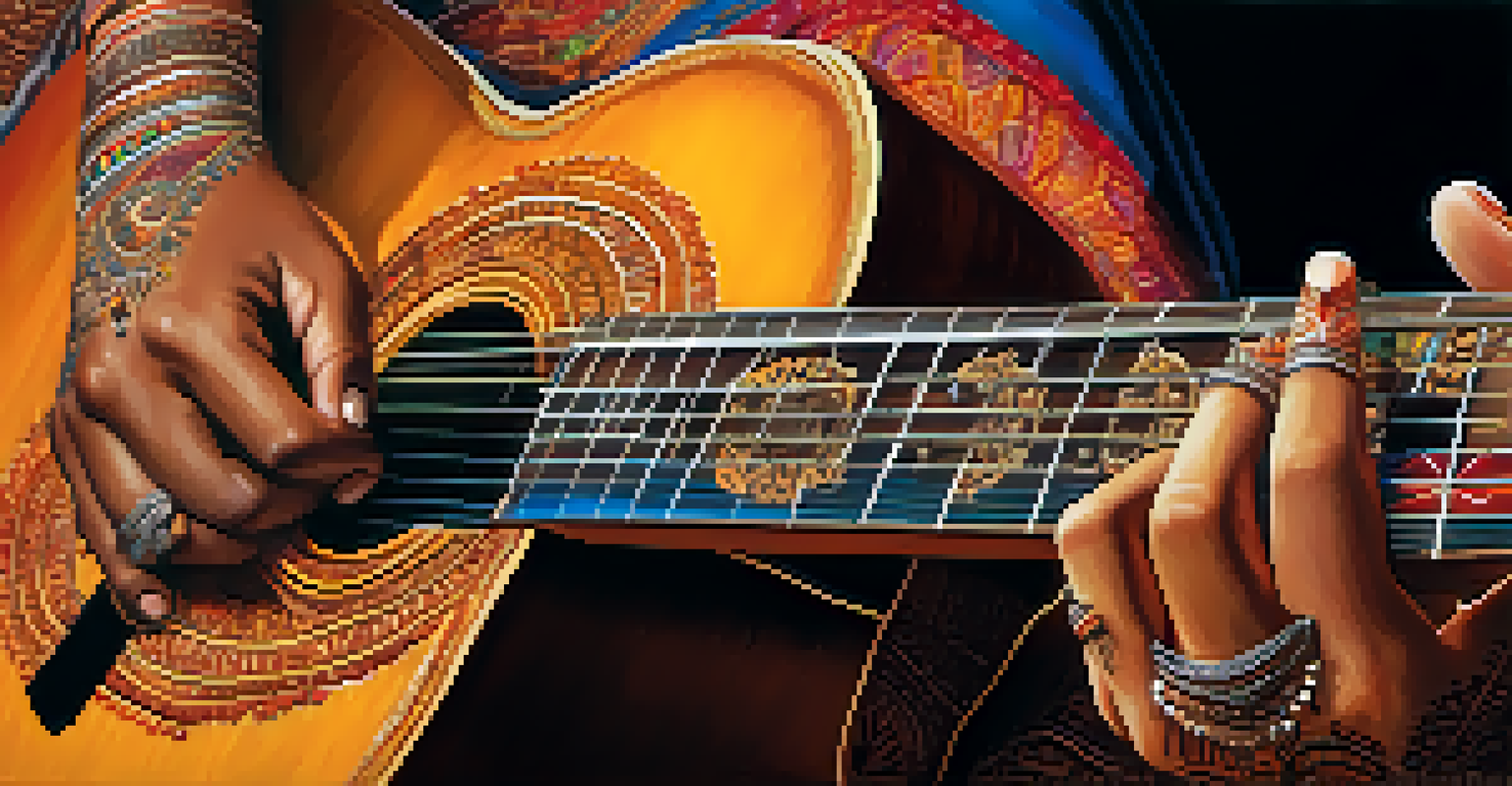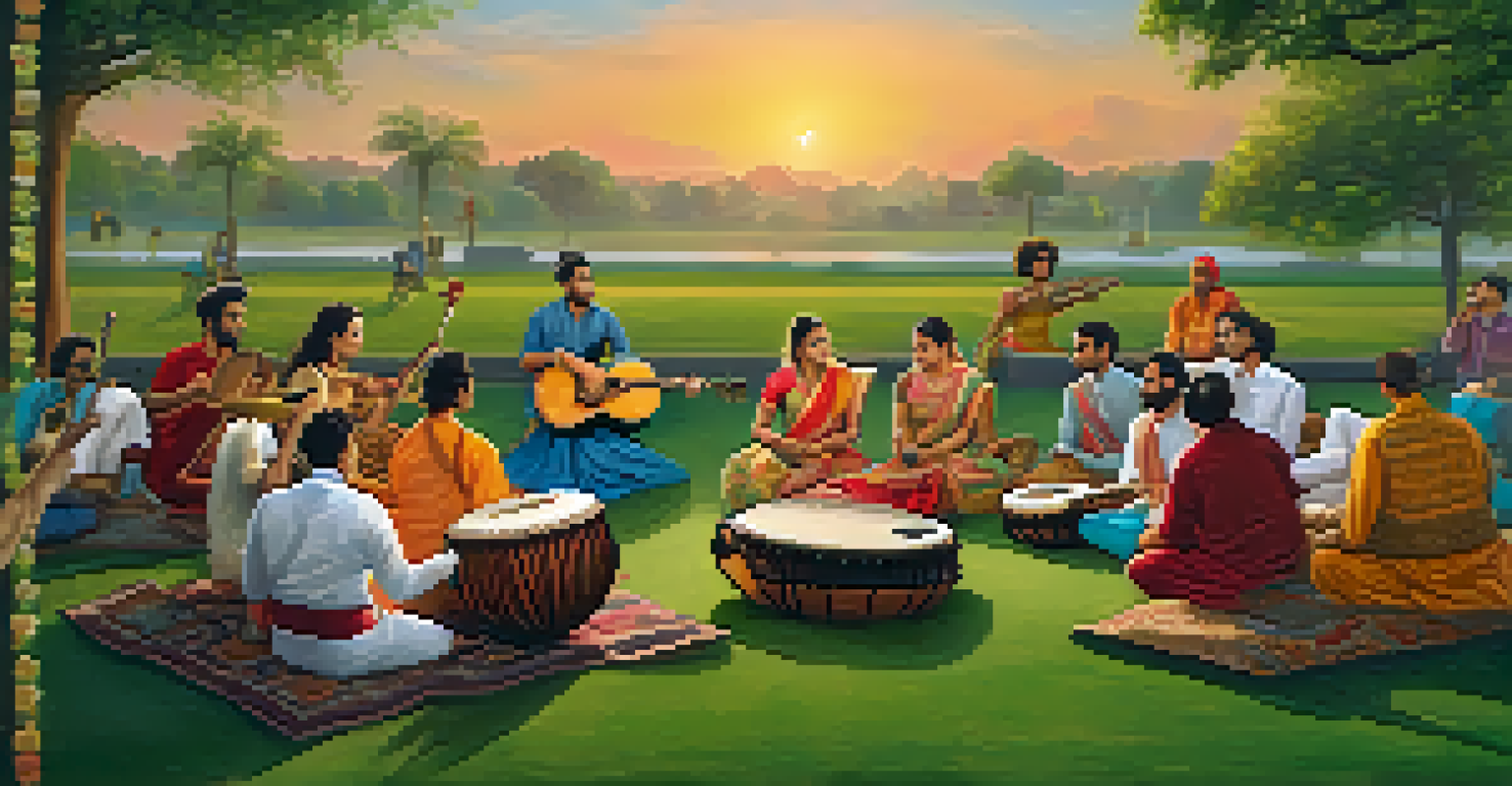The Role of Guitar in Traditional Indian Classical Music

Understanding the Guitar's Place in Indian Classical Music
The guitar, while not a traditional instrument in Indian classical music, has carved a niche for itself over the years. It offers a unique sound that blends beautifully with the intricate melodies of Indian ragas. This adaptability makes it a fascinating addition to the traditional ensemble, showcasing its versatility.
Music is the universal language of mankind.
Traditionally, instruments like the sitar and sarod have dominated the scene, each with a rich history and deep cultural significance. However, the guitar brings a fresh perspective, often appealing to younger audiences and bridging the gap between Western and Indian musical styles. This fusion creates a vibrant musical dialogue that enriches performances.
Moreover, the guitar’s accessibility has encouraged many musicians to experiment with it in classical contexts. As artists explore various genres, the guitar's presence in Indian classical music becomes a testament to the evolving nature of cultural expressions.
The Guitar’s Unique Sound and Techniques in Classical Music
One of the most captivating aspects of the guitar is its tonal diversity. Through techniques like slide and fingerpicking, guitarists can mimic the sounds of traditional Indian instruments, creating a seamless blend of styles. This ability to adapt traditional soundscapes allows for innovative interpretations of classical pieces.

Guitarists often employ alternate tunings to resonate with the scales used in Indian music, enhancing the instrument's compatibility with ragas. This approach not only showcases the guitarist’s skill but also pays homage to the rich musical heritage of India. The result is a performance that honors tradition while inviting modern influences.
Guitar Enhances Indian Classical Music
The guitar's unique sound and techniques allow it to blend seamlessly with traditional Indian ragas, enriching performances.
Additionally, the guitar's portability makes it an appealing choice for collaborative performances. Musicians can easily incorporate it into various settings, from intimate gatherings to large concerts, making it a versatile companion for classical music's evolving landscape.
Influential Guitarists in Indian Classical Music Scene
Several talented guitarists have emerged as pioneers in integrating the guitar into Indian classical music. Artists like Rudra Pratap Singh and Sanjay Mishra have not only showcased their virtuosity but also redefined the instrument's role in this genre. Their innovative techniques and interpretations have inspired many budding musicians.
The guitar is a miniature orchestra in itself.
These guitarists often draw from their diverse musical backgrounds, blending Western styles with traditional Indian practices. This fusion creates a unique sound that resonates with audiences both familiar and unfamiliar with classical music. Their contributions enrich the cultural tapestry of India, making the guitar an essential part of the conversation.
As these artists continue to perform and teach, they pave the way for future generations to explore the guitar in classical contexts. Their dedication to pushing boundaries ensures that the guitar remains a relevant and exciting instrument within the Indian classical music community.
The Role of Guitar in Traditional Performances
In traditional performances, the guitar can serve multiple roles, from providing melodic support to enhancing the rhythmic foundation. It complements vocalists and instrumentalists alike, allowing for a dynamic interplay that enriches the overall experience. This collaborative spirit is at the heart of Indian classical music, and the guitar fits right in.
Often, guitarists are seen accompanying classical dancers, adding depth to the performance. The instrument's ability to convey emotion through melody enhances the storytelling aspect of dance, creating a mesmerizing synergy. This relationship between music and movement exemplifies the artistic possibilities when the guitar is incorporated into traditional performances.
Fusion Creates New Musical Genres
Collaborations between Western and Indian musicians using the guitar have led to innovative genres like Indo-jazz, showcasing cultural fusion.
Furthermore, the guitar's involvement in these performances showcases its adaptability and willingness to embrace various musical forms. As musicians continue to experiment, the guitar's presence in classical settings is likely to expand, inviting new interpretations and experiences.
Fusion of Western and Indian Musical Styles with Guitar
The guitar acts as a bridge between Western and Indian musical traditions, highlighting the beauty of cultural fusion. This blending of styles has resulted in the emergence of unique genres, such as Indo-jazz and fusion music, where the guitar plays a pivotal role. These genres invite listeners to experience the richness of both traditions in a fresh way.
Artists like Trilok Gurtu and John McLaughlin have famously collaborated, showcasing how the guitar can transcend boundaries. Their innovative compositions demonstrate the guitar's flexibility, creating music that resonates across cultures. Such collaborations not only enrich individual artistry but also promote cross-cultural appreciation.
As the world becomes more interconnected, the guitar continues to serve as a powerful tool for musical exploration. This fusion not only enriches the Indian classical music landscape but also encourages musicians to embrace creativity, pushing the boundaries of what is possible.
The Future of Guitar in Indian Classical Music
As we look ahead, the future of the guitar in Indian classical music seems promising. With an increasing number of musicians experimenting with the instrument, we can expect to see innovative approaches that challenge traditional norms. This evolution will undoubtedly lead to exciting new compositions and performances.
Moreover, educational initiatives that promote the guitar within classical music contexts will likely inspire a new generation of musicians. Workshops and masterclasses can provide aspiring guitarists with the tools they need to navigate this unique blend of styles. Encouraging collaboration among musicians from different backgrounds will further enrich the learning experience.
Promising Future for Guitarists
With ongoing experimentation and educational initiatives, the guitar's role in Indian classical music is set to evolve and expand.
Ultimately, the guitar's role in Indian classical music is a testament to the genre's adaptability and growth. As artists continue to explore its potential, the guitar will undoubtedly carve out a significant place in the future of this rich musical tradition.
Conclusion: Embracing the Guitar’s Contribution to Tradition
The guitar's journey within Indian classical music is a remarkable example of cultural evolution. By embracing this instrument, musicians have opened doors to new interpretations and collaborations that honor tradition while inviting innovation. This balance is essential for the continued relevance of classical music in a rapidly changing world.
As the lines between genres blur, the guitar stands as a symbol of unity, showcasing how diverse influences can come together to create something beautiful. It encourages musicians to think creatively and push the boundaries of their craft, fostering a spirit of openness and exploration.

In conclusion, the guitar's growing presence in Indian classical music not only enriches the genre but also enhances its accessibility. By welcoming this instrument into traditional performances, we celebrate the ongoing journey of music as a living, breathing art form.